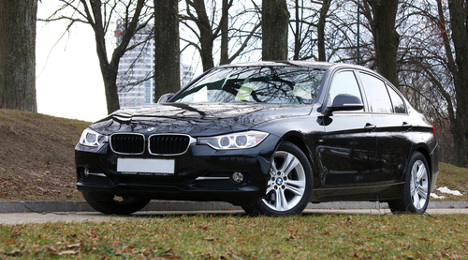Some new-car models, particularly a few luxury vehices, are resold after just one year of ownership signficantly more often than the average car is, according to a newly released analysis by iSeeCars.com
While just 1.5 percent of car buyers resell their new cars within the first year of ownership, iSeeCars spotlighted 11 models thatn see at least twice the rate of resale when compared to average car, says the research firm.
iSeeCars analyzed more than 24 million individual new car sales and counted how many of those new cars were reselling as used within the first year.
Six of the 11 models are from BMW and Mercedes-Benz.
The top three models include the BMW 3 Series, BMW 5 Series, and Mercedes-Benz C-Class
“All re-sold at rates that are quadruple the average of all models,” said iSeeCars.com
“This is partly attributed to dealers reselling their loaner vehicles which they have an oversupply of due to incentives from the automakers.”
The following is a list of the new cars resold most often as used within the first year of ownership, according to iSeeCars.com, along with percentage going this route.
BMW 3 Series, 8.0%
BMW 5 Series, 7.1%
Mercedes C-Class, 6.1%
Nissan Versa Note, 4.0%
Dodge Dart, 3.9%
BMW X3, 3.9%
BMW 4 Series, 3.9%
Mercedes E-Class, 3.9%
Chrysler 200, 3.8%
Subaru WRX, 3.3%
Nissan Versa, 3.2%
"While some might be surprised that these luxury brands top the list, these auto manufacturers offer their dealers incentives to buy new cars to use as loaner vehicles, which are then sold as used when they are still under a year old," Phong Ly, chief executive officer of iSeeCars.com said in a news release. "This is a marketing strategy with a two-fold purpose. It puts brand-new models in the hands of current owners when they bring their cars in for service, increasing the likelihood that they will buy another car from that brand. In addition, it essentially increases the brand's new car sales, which help to give them the ability to claim the title of 'top luxury brand', something that BMW and Mercedes-Benz compete for every year."
iSeeCars suggests that one reason these models are being resold within the first year of ownership is linked to quality or perceived quality of the cars.
Aside from the BMW and Mercedes-Benz models, the remaining models on the list, all ranked an average of three stars or less in the J.D. Power 2016 U.S. Initial Quality Study, which surveys consumers after 90 days of ownership, iSeeCars said.
"It's not surprising that consumers would make a change after a short amount of time if they felt the quality was lacking," Ly said. "After all, a new car is a very expensive purchase and one that consumers spend a significant amount of time with multiple times a day."
Additionally, the high resale rate of the 11 models represents an excellent opportunity to find bargains on them.
Nine of the 11 models have an estimated discount 12.7 percent higher than the average car, according to iSeeCars.com.
The following is a list of each model's average discount.
Chrysler 200: 29.9%
Dodge Dart: 27.4%
Nissan Versa Note:20.2%
Mercedes C-Class: 19.6%
Mercedes E-Class: 19.3%
BMW 5 Series: 18.2%
BMW 3 Series: 18.0%
BMW 4 Series: 17.3%
Nissan Versa: 14.1%
BMW X3: 12.7%
Subaru WRX: 6.2%
iSeeCars analyzed more than 24 million individual new car sales of model years 2015-2017 within calendar years 2015 and 2016.
The firm used each car's Vehicle Identification Number to see whether the car was re-listed between four months and a year of its sell date.
New cars with over 500 miles and used cars with less than 4000 miles were excluded from the study.
The amount of cars relisted as used was then articulated as a percentage of the number of new car sales by iSeeCars.com.
A deeper look into the latest certified pre-owned vehicle sales information compiled by Autodata Corp. showed eight automakers that often generate some of the largest CPO volume are off to strong starts again in 2017.
Of those eight OEMs, each one has posted year-to-date CPO sales gains of at least 8 percent. Leading the charge in terms of an increase in actual units is BMW, which has turned 21,462 certified units in two months, according to Autodata. That figure represents a 27.3-percent lift year-over-year.
The other OEMs that are enjoying productive beginnings of their CPO sales year include:
—Acura: 7,298 units, up 31.4 percent
—Cadillac: 6,566 units, up 45.3 percent
—Honda: 38,639 units, up 8.8 percent
—Infiniti: 5,389 units, up 25.1 percent
—Kia: 11,940 units, up 22.1 percent
—Nissan: 30,622 units, up 8.5 percent
—Volvo: 2,814 units, up 21.0 percent
The single OEM with the highest CPO sales figure through the first two months of the year is Toyota. Autodata indicated the automaker turned 61,833 certified units in January and February.
Besides Honda and Nissan, the other two automakers to move at least 30,000 CPO units during the first two months of 2017 were Ford/Mercury (32,882) and Chevrolet (38,045).
While industry observers spotted some factors impacting new-car sales, franchised dealerships produced strong results in moving certified pre-owned vehicles as the industry generated nearly a double-digit gain on a sequential basis.
According to information supplied by Autodata Corp. on Wednesday, February’s CPO sales came in at 211,475 units; a figure relatively unchanged from the same month last year but it represented a 9.8-percent jump from January.
Autodata said year-to-date sales through February now sit at 404,076 units, marking a 0.4-percent lift versus the same juncture a year ago.
Analysts pointed out there were 24 selling days in February of this year and last year as well as January. That element meant the daily selling rate was 8,811.
Looking a little deeper into the figures, Autodata determined year–over-year domestic CPO brand share softened by 2.9 percentage points to 33.8 percent. Meanwhile, European share ticked up 0.6 percentage points to 16.9 percent. The Asian share also increased, rising by 2.3 percentage points to 49.3 percent.
Perhaps what helped to goose CPO sales in February was shopper traffic dealerships generated through their websites, especially potential buyers scanning inventory via a mobile device. Dealer.com, a Cox Automotive company based in Burlington, Vt., that runs 62 percent of the nation’s dealer websites, shared some insights this week.
“Overall traffic on our Dealer.com websites was strong in February — at a good level — although the level is roughly flat versus year ago,” Andy MacLeay, director of digital marketing at Dealer.com.
“What we are seeing is continued, strong migration to mobile,” MacLeay continued. “People seem to be on the lots, viewing data, comparing cars. On President’s Day weekend, the spike in mobile shopping was 25 percent higher than last year and 34 percent higher than 2015.”
Editor’s note: Watch for an upcoming report from Auto Remarketing detailing the February CPO sales figures from of the leading automakers in the space.
Industry observers see trends in the new-vehicle space that are making the delivery of new metal more challenging and, as a result, likely to impact how efficiently dealerships can turn their used-vehicle inventory.
Analysts from Autotrader, Edmunds and Kelley Blue Book all shared data and insights with Auto Remarketing on Wednesday that pointed to possible challenges for franchised dealerships that might face the challenge of finding buyers for their new models — which in some cases are taking the amount of days to turn not seen in almost eight years.
Meanwhile, off-lease volume continues to grow with units ripe to be retailed as certified pre-owned is on the rise.
“(New-vehicle) inventory is starting to swell, which is concerning considering that we’re still months away from the peak summer selling season,” Edmunds executive director of industry analysis Jessica Caldwell said in a message to Auto Remarketing.
Caldwell indicated days to turn has reached its highest level since July of 2009, and new vehicle inventory was up 9 percent year-over-year in February. Edmunds offered this metrics regarding days to turn in February:
• Subcompact cars had a days to turn of 102 days.
• Large cars had a days to turn of 86 days.
• Midsize cars had a days to turn of 82 days.
• Industry average was 74 days.
“The automakers are in a tricky spot: aggressive incentives are already starting to eat into profits and residuals, but it takes discipline to pull back the production reins in what’s still a fairly strong market,” she said.
And what about the CPO department?
“The used vehicles that will feel the squeeze are off-lease and otherwise near-new used,” Caldwell said. “We know those particular types of inventories will climb due to high lease rates so having an abundance of new inventory will create more pricing pressure for those vehicles. The older used vehicles have short supply with higher demand so those should not feel the squeeze from climbing new-car inventories."
Kelley Blue Book senior analyst Alec Gutierrez acknowledged during a conference call on Wednesday that “we are seeing inventory build up across the spectrum” as he put new-vehicle days’ supply at close to 80 days, up from about 70 days a year ago. Gutierrez indicated automakers are slapping more than $3,500 on the hood in incentives to get new models rolling over the curb; a trend a bit surprising since February typically is a slow month for new-car sales anyway.
“You see where inventory levels are at and I think manufacturers are making a concerted effort to try to get the numbers down to some extent,” Gutierrez said. “You would think in February with the expectations and with respect to seasonality, we all know this is a slow month. This would be a month where you could expect to pull back on incentives a bit and a little bit of reduced performance, and it wouldn’t really break anyone’s expectations.
“But I think at the end of the day, consumers have seen rising incentive levels,” he continued. “We know that typical consumers are going to be in the marketplace typically for 60 to 90 days if not more ahead of their purchase. If they’re keeping tabs on incentive activity and trying to time their overall decision of when to head to the dealership to finalize the deal, a sudden cutback in incentives could certainly sway that to wait or seek an alternative.
“To some extent, incentives remain high because they have been high. Until we see a meaningful impact on overall inventory levels and days’ supply, it’s going to be a slow ramp back down with incentives. And at this point, we’re still seeing the trend head upward,” Gutierrez went on to say.
So if incentives are going to stay high, what’s that trend going to do to dealerships’ used-vehicle prospects?
“With days’ supply where it is and the incentive load at $3,600-plus per unit, there’s most definitely going to be a trickle-down effect impacting the used-car side,” Guiterrez said. “In fact, when we look at overall performance of late-model inventory at auctions across the U.S., we’re seeing about a 2 percent reduction in terms of what dealers are willing to pay at auction year-over-year. If you look at it in terms of retained value, the auction value as a percent of vehicle’s original MSRP, you’re seeing more like a 3-point reduction.
“Although transaction prices on the new-car side remain very strong, that overall incentive load coupled with high days’ supply, not to mention increasing supply on the wholesale side from off-lease inventory returning in greater numbers month in and month out, we are seeing not insignificant downward pressure being applied on used-car values,” he continued. “That trickle-down effect is certainly taking place and it’s something we expect to continue in the months ahead.”
During Wednesday’s conference call, Autotrader senior analyst Michelle Krebs pointed out that there were “healthy” shopping activity on dealership websites last month. She also mentioned the latest analysis from the Conference Board placed consumer confidence at the highest level since 2011 with a strong sentiment of people likely to make a vehicle purchase.
But should it be a new model or a certified unit?
“From a consumer point of view, it’s going to take a little bit more studying to which is the better deal, the off-lease vehicle and sold as a certified pre-owned versus a new one that’s heavily incentivized,” Krebs said.
“Of course, there are two different stories there, too,” she continued. “The price drops have been most significant on traditional cars and less so since truck prices have been stronger as are sport utility vehicles. (The used-car market) almost a mirror image of the new-car market.”
While there might be a glut of new-vehicle inventory gumming up the system now, Krebs advised that the industry keep watch of what happens as the first quarter unfolds.
“I think we should be careful. January and February are lowest sales volume months of the year,” Krebs said. “I think we should pay attention to March and later in the spring. Those months are the strongest and we’ll get a much stronger indication of where 2017 is headed.”
The first two publicly traded groups to share their 2016 financial statements — AutoNation and Group 1 Automotive — posted mixed results within their used-vehicle departments.
Group 1 reported that its dealerships retailed 129,131 used vehicles last year, representing a 4.0-percent increase above the 2015 figure. The company also generated a 3.3-percent rise in retail used-vehicle gross profit as its revenue in the used-car space climbed 6.7 percent.
For the year on a per unit basis, Group 1 reported retail gross of $1,472 on its used-vehicle turns. That figure softened by 1.7 percent year-over-year.
Meanwhile, the F&I offices at Group 1 stores compiled a $74 increase in gross per unit, ending the year at $1,599.
At AutoNation, the dealer group said it turned 225,713 used vehicles in 2016, which ended up being a figure 1,577 units less than the previous year. And the group’s gross profit per used unit softened by $93 to settle at $1,484 for the year.
But like Group 1, AutoNation made improvement in the F&I office as gross per unit on the back-end of deliveries jumped by $54 year-over-year to finish 2016 at $1,588.
Both Asbury Automotive Group and Penske Automotive Group are scheduled to release their year-end results on Tuesday. Later this month, both Lithia Motors and Sonic Automotive will share their numbers, too, on Feb. 15 and Feb. 21, respectively.
If he joins Asbury’s conference call with the investment community, it likely will be the last time for Keith Style, who recently provided notice of his intention to resign from the position of senior vice president and chief financial officer of the company effective March 7.
“We thank Keith for his valuable service to Asbury over the last 13 years and wish him well in his next endeavor,” Asbury president and chief executive officer Craig Monaghan said in a news release. “We are pleased that Keith has agreed to remain with the company until after we file our annual report on the Form 10-K for the year ended Dec.31, 2016.”
Asbury indicated Style is departing in order to accept the position of president and chief financial officer of a privately owned company.
“I would like to thank Craig for his mentorship during our time working together,” Style said. “I’m very thankful for the opportunities and support both he and the Board provided me during my years at Asbury. It's been a privilege to work alongside the high-performing members of the Asbury team.
Asbury also announced that William Stax, corporate controller and chief accounting officer of the company, was appointed interim principal financial officer effective March 8 while the dealer group conducts a search for a new chief financial officer.
Car sales in December closed exceptionally strong because there was likely a pull forward effect, especially given a number of attractive incentives offered across the industry.
January may be suffering a bit of a hangover after the impressive deals seen at the end of last year, according to, Alec Gutierrez, senior analyst for Kelley Blue Book, and Michelle Krebs, senior analyst for Autotrader
The senior analysts hosted February’s automotive sales day conference call on Wednesday.
It looks as if new-car shoppers are “taking a bit of a breather,” said Krebs.
“Dealers are telling us showroom traffic for new cars is down a bit, and they’re telling us used-car traffic remains pretty firm,” she said.
Gutierrez explained that the year ended with a lot of incentives and that January is generally heavy for incentives as well.
“Industry incentive spend in December was close to $4,000 per unit so there are likely a lot of consumers who jumped ahead to take advantage of year-end closeout sales,” said Gutierrez.
He said the environment across the board is still relatively strong and conducive towards a continued strength.
“The unemployment rate remains very low at below 5 percent and consumer confidence remains relatively steady,” Gutierrez added.
He said he expects January to closeout at a new-car annual selling pace of about 17.4 million units overall.
“For the year, right now we’re bench marking sales likely in the low 17 million, 17.2, 17.3 (range) — somewhere around there,” said Gutierrez.
“I think consumers will still not have an issue getting affordable financing on a new- or used-car purchase or lease for that matter — which remains at 30 percent penetration.”
Used-car sales are predicted to do well in 2017, following what was a record year for used-car sales, according to two automotive industry leaders.
In an AIADA AutoTalk webinar in late December, KAR Auction Services chief economist Tom Kontos and David Lim — vice president and equity analyst at Wells Fargo Securities — discussed last year’s used-car sales and what to expect this year.
“It looks as if the cars that are coming back off lease, as repos, as trade-ins, as off-rental or as off fleet units are all finding a new home in the retail side of the business,” said Kontos. “Used-car sales through November, according to NADA data, for franchise dealers are up 3.6 percent; and for independent dealers, used-car sales are up 6 percent.
“So, the retail sales of used cars, if you combine those, they’re in the 4.2 percent range, which is pretty much exactly the rate of growth in supply (in 2016) at auction.”
Lim also agrees that used vehicles should do well in 2017. He said public auto dealers have been vocal about the opportunity in used vehicles, as many have launched standalone used-car outlets.
“There’s definitely opportunity where you know these franchise dealers are going to get first dibs and in our view, I think having first dibs is actually a benefit for guys that also have standalone stores where they could feed those stores with the inventory,” he said.
They also touched on the certified pre-owned market.
Autodata Corp. reported that there were 2.64 million CPO sales in 2016, which was the sixth straight best-ever sum for this rapidly expanding market.
Lim said CPO programs are attractive and bring customers into the fold who can’t afford a brand-new luxury vehicle, but can purchase a CPO and maybe someday down the road buy the brand new version of their CPO vehicle.
“The impression that I have is that (2017) could be a pretty good year for used vehicles,” Lim said.
There was a 3-percent uptick in online new-car shopping in November, while used cars showed a 1-percent drop, according to analysis from Dealer.com director of analytics James Grace.
The reason for these numbers?
A big new-car push from automakers to make up for lost ground as the year draws to an end.
“We did a study last month, just before the end of the election showing that all the election ad spend was sort of eating up traditional advertising real estate — and by traditional I mean radio, TV, etc. — and driving up the cost of online real estate in battleground states,” Grace said in a phone interview Friday.
“The election, especially this year being what it was, sort of created a tough environment for certainly local dealers but also OEMs getting access to the typical ad space that they would have had, as well,” he said.
There had been a few months where new-car sales either slowed or were flat, Grace said. Automakers responded with a big marketing push in November, a month that not only saw the election season come to an end but also the Thanksgiving and Black Friday shopping weekend.
As Grace put it, automakers “doubled-down” as they chase annual sales targets.
“There’s just a big push on the new-car front based on, in my view, a combination of the election and the relative plateauing of the industry. But everybody has targets for the year that they’re not wanting to miss, for obvious reasons, from a Wall Street perspective,” Grace said.
“So that’s really just driving a lot of activity on the new-car front. There’s a lot of deals to be had there, and in general, that’s sort of robbing from used,” he said.
Granted the increase in new compared to the decrease in used was not a one-to-one ratio, he said, “but I think a lot of people that would ultimately normally end up in a used vehicle are ending up in a new vehicle just because there’s such strong pushes from the OEMs and available inventory; there’s deal to be had there.”
Then, of course, there is leasing. An analysis from Edmunds.com indicates that lease penetration on the new-car side has never been higher. According to Edmunds, year-to-date lease penetration through October is at 30.7 percent.
And given the propensity for leasing these days, there may be would-be used-car buyers who perhaps opt for a new-car lease.
Grace pointed out that the data they’ve seen via Autotrader and Dealer.com suggest that most people are “payment buyers.”
“They’ve got a number in mind and they’re trying to get into the best vehicle they can for that number. So when lease deals, especially with new-car incentives starting to be the same number as that off-lease used vehicle, people are for sure going to choose the new when given that option,” he said.
“So, I do think that the increased trend on the leasing side, combined with the incentives, is just bringing that gap between new and used payments, if not prices, too close for consumers to opt out of the new.”
Enterprise Holdings and its affiliate Enterprise Fleet Management delivered record results in fiscal year 2016.
For the 12-month period ended July 31, the company generated $20.9 billion in revenue. That was an 8.1-percent increase over FY 2015, according to a news release.
As privately held companies, they do not disclose net income.
Enterprise Holdings and Enterprise Fleet Management together own nearly 1.9 million vehicles and more than 9,600 fully staffed locations dozens of countries, making Enterprise the world’s largest car-rental company as measured by revenue, fleet and employees.
“We not only are seeing consistent and significant growth in U.S airport market share, but also across our business lines and in local neighborhoods,” said Pamela Nicholson, president and chief executive officer at Enterprise Holdings Inc., which owns the Enterprise Rent-A-Car, National Car Rental and Alamo Rent A Car brands.
“Consider that our customers are logging more than 25 billion miles throughout the world every year. And many of those miles are driven locally in their very own communities, mostly in late-model, fuel-efficient vehicles,” Nicholson added. “That means our business offers some of the most effective and sustainable options in the ground transportation sector today — and we will continue to do so, even as infrastructure and technology, including autonomous vehicles, evolve in the future.”
Enterprise, National and Alamo brands operate in more than 85 countries and territories on five continents.
“We at Enterprise Holdings are proud of our leadership role in the car rental, travel and automotive industries,” Nicholson said. “Every single day, Enterprise, National and Alamo employees put customers first — regardless of whether the rental is across town or halfway around the world.”
During FY2016, Enterprise Holdings added multiple franchise locations, including Belize, Ecuador, Jamaica, Jordan, Honduras, Luxembourg, Mexico, New Zealand, Qatar, Saudi Arabia, Tortola, Trinidad & Tobago, Turks & Caicos, the United Arab Emirates and Uruguay.
Family owned and operated
Enterprise was founded in 1957 by Jack C. Taylor. Taylor passed away during FY16, but his children remain in senior management positions. His son, Andrew, is executive chairman of Enterprise Holdings, while his daughter, Jo Ann Taylor Kindle, is president of the Enterprise Holdings Foundation.
Two of Jack Taylor’s granddaughters also serve key roles: Christine Taylor as executive vice president and chief operating officer of Enterprise Holdings, and Carolyn Kindle Betz as vice president and executive director of the Enterprise Holdings Foundation.
One of Taylor family’s goals is to carry on the company’s commitment to community-focused philanthropy.
To that end, the Enterprise Holdings Foundation provided $27.3 million in grant funding to charitable causes during FY16. Eighty-nine percent of the grant requests the foundation fulfilled came from employees to help community causes that are of personal importance to them. Large-scale donations in 2016 included support for the American Red Cross Annual Disaster Giving Program and the Canadian Red Cross Fort McMurray, Alberta, disaster relief efforts.
Enterprise Holdings recently published its FY2016 Sustainability Update, highlighting key initiatives such as responsible product lifestyle and growth of urban mobility programs.
“We are seeing more and more questions about sustainability issues and metrics as part of the formal RFP process,” said Nicholson. “That is because major corporate accounts with defined sustainability goals — including Enterprise Holdings — are evaluating and measuring their respective supply chains to a much greater degree than ever before.”
Enterprise Holdings is the only company in the international car rental industry — and one of a handful in the global travel industry — to complete its sustainability reports and updates in accordance with Global Reporting Initiative (GRI) G4 “Core” Guidelines. This annual documentation articulates goals and provides transparency as well as accountability for Enterprise Holdings and its key stakeholders.
The view appears rosy for pre-owned operations at Sonic Automotive, including expansion in its EchoPark standalone used-car stores.
The dealer group had its best-ever quarter for used retail sales and achieved more than 58-percent growth in its EchoPark sales, according to its quarterly earnings release.
Sonic retailed 30,933 used cars in the third quarter, an all-time high and a 1.5-percent year-over-year improvement. Through three quarters of the year, it has sold 89,553 used retail units, up from 88,903 used retail sales through Q3 of 2015.
The company’s EchoPark stores moved 1,458 units for a 58.5-percent year-over-year spike. It now has five Denver-area EchoPark outlets with expansion to come in 2017.
EchoPark growth “is continuing with two new stores operating during the quarter,” Sonic chief executive officer Scott Smith said in a news release.
“We are very excited that combined, our original three stores generated positive cash during the third quarter,” Smith said. “Our sixth Denver market store, located in Colorado Springs, will open during the first half of 2017. In addition, we will break ground on our first Texas locations in the first half of 2017.”
Offering some overall commentary on the quarter and some used-car-specific insight, Sonic executive vice president of operations Jeff Dyke said in a news release: “We had another record quarter in fixed operations, F&I and pre-owned, but did face headwinds during the quarter. Stop-sale vehicles, BMW brand performance and weakness in one of our most profitable markets, Houston, negatively impacted our results. Given BMW's brand performance during the quarter and that BMW stores represent over 30 percent of our profitability, we were negatively impacted.
“We have absolute confidence in the BMW brand and are working with our partners at BMW to address this bump in the road, which we view as a short-term issue. We are making progress with our stop-sale inventory with less than 2,200 units on hand at the end of the third quarter of 2016 compared to nearly 4,700 units on hand at the end of the second quarter of 2016,” he added. “Finally, we expect weakness to continue in the Houston market, especially in our high-line stores, through at least the end of the year as we believe the energy sector's recovery may take time to gain some momentum."
“Our One Sonic-One Experience stores are also making good progress and we plan to launch the technology in our first BMW store in the first quarter of 2017. The technology, pricing tools and OSOE playbook have continued to develop nicely and we are excited to see how these tools can be leveraged in a BMW retail operation,” Dyke continued. “We are confident that the implementation of OSOE will greatly enhance our BMW customers' buying experience as our EchoPark stores and current OSOE stores boast some of the very highest social media reputation scores in the industry.”












